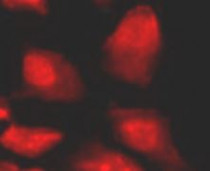ARG55292
anti-AIRE antibody
anti-AIRE antibody for ICC/IF,Western blot and Human,Mouse,Rat
Gene Regulation antibody; Immune System antibody
Overview
| Product Description | Rabbit Polyclonal antibody recognizes AIRE |
|---|---|
| Tested Reactivity | Hu, Ms, Rat |
| Tested Application | ICC/IF, WB |
| Host | Rabbit |
| Clonality | Polyclonal |
| Isotype | IgG |
| Target Name | AIRE |
| Antigen Species | Human |
| Immunogen | Synthetic peptide of Human AIRE (NP_000374.1) |
| Conjugation | Un-conjugated |
| Alternate Names | APECED; Autoimmune regulator; APS1; APSI; Autoimmune polyendocrinopathy candidiasis ectodermal dystrophy protein; AIRE1; PGA1; APECED protein |
Application Instructions
| Application Suggestion |
|
||||||
|---|---|---|---|---|---|---|---|
| Application Note | * The dilutions indicate recommended starting dilutions and the optimal dilutions or concentrations should be determined by the scientist. | ||||||
| Positive Control | MCF7 |
Properties
| Form | Liquid |
|---|---|
| Purification | Affinity purification with immunogen. |
| Buffer | PBS (pH 7.3), 0.02% Sodium azide and 50% Glycerol |
| Preservative | 0.02% Sodium azide |
| Stabilizer | 50% Glycerol |
| Storage Instruction | For continuous use, store undiluted antibody at 2-8°C for up to a week. For long-term storage, aliquot and store at -20°C. Storage in frost free freezers is not recommended. Avoid repeated freeze/thaw cycles. Suggest spin the vial prior to opening. The antibody solution should be gently mixed before use. |
| Note | For laboratory research only, not for drug, diagnostic or other use. |
Bioinformation
| Database Links | |
|---|---|
| Gene Symbol | AIRE |
| Gene Full Name | autoimmune regulator |
| Background | This gene encodes a transcriptional regulator that forms nuclear bodies and interacts with the transcriptional coactivator CREB binding protein. The encoded protein plays an important role in immunity by regulating the expression of autoantigens and negative selection of autoreactive T-cells in the thymus. Mutations in this gene cause the rare autosomal-recessive systemic autoimmune disease termed autoimmune polyendocrinopathy with candidiasis and ectodermal dystrophy (APECED). [provided by RefSeq, Jun 2012] |
| Function | Transcriptional regulator that binds to DNA as a dimer or as a tetramer, but not as a monomer. Binds to G-doublets in an A/T-rich environment; the preferred motif is a tandem repeat of 5'-. ATTGGTTA-3' combined with a 5'-TTATTA-3' box. Binds to nucleosomes (By similarity). Binds to chromatin and interacts selectively with histone H3 that is not methylated at 'Lys-4', not phosphorylated at 'Thr-3' and not methylated at 'Arg-2'. Functions as a sensor of histone H3 modifications that are important for the epigenetic regulation of gene expression. Functions as a transcriptional activator and promotes the expression of otherwise tissue-specific self-antigens in the thymus, which is important for self tolerance and the avoidance of autoimmune reactions. [UniProt] |
| Research Area | Gene Regulation antibody; Immune System antibody |
| Calculated MW | 58 kDa |
| PTM | Phosphorylated. Phosphorylation could trigger oligomerization. |
Images (2) Click the Picture to Zoom In







